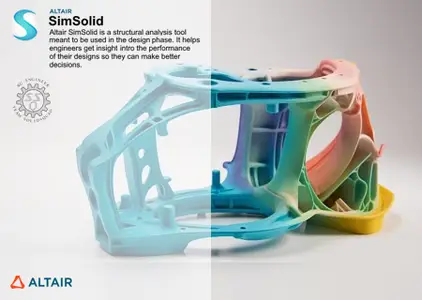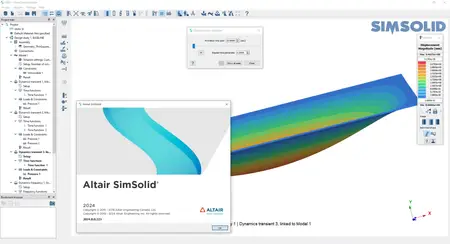Altair SimSolid 2024.0 Win x64

Free Download Altair SimSolid 2024.0 | 3.4 Gb
Altairhas releasedSimSolid 2024.0is a structural analysis software developed specifically for rapidly evolving design processes, enabling the analysis of fully-featured CAD assemblies in minutes without meshing
Owner:Altair
Product Name:SimSolid
Version:2024.0 with Tutorials & Verification Models
Supported Architectures:x64
Website Home Page :www.altair.com
Languages Supported:english
System Requirements:Windows *
Size:3.4 Gb.
Altair SimSolid 2024 Release Notes
Composites (Beta)
SimSolid supports converting imported skins or surfaces into layered composites. The imported skin can be mid-surface, top or bottom layer of the solid. Creation of laminates that consist of several plies with assigned thickness is also supported. Currently, only isotropic materials can be applied to all plies in the laminate. SimSolid implicitly creates solids that represent every ply in the laminate. All results can be queried across all the plies in the model.
This feature also allows performing design changes within SimSolid by modifying the sheet thickness and materials which can aid in carrying-out optimization studies.
Composites are also supported for all the solutions.
Nonlinear transient thermal
Transient thermal solution can now include temperature-dependent material properties. It includes temperature dependent material properties for thermal conductivity, specific heat capacity, convective heat transfer coefficient and density.
Complex eigen value solution
Complex eigen value solutions, including frequencies and damping, can now be output by defining damping on bushings or shock absorbers.
Wind load
Wind load is now supported as a boundary condition in structural analysis. This feature automatically evaluates and applies variable pressure based on an empirical equation. The input includes ground, wind direction, wind profile, height axis, air density, friction coefficient and shape factor.
Wind load also has an option to enable shielding, which restricts application of pressure on surfaces that have obstructions along the wind direction. Wind load, hydrostatic pressure and uniform pressure have all been grouped together under pressure.
Shock absorber
A new virtual connector called shock absorber is now supported. It is defined by stiffness and damping along the length of the shock absorber.
Dynamics
– Power Spectral Density (PSD) functions can now be visualized and input on a log-log scale in addition to the linear scale.
– For modal analysis, displacements can now be output to UNV file for rigid body modes as well.
– Evaluation of frequency and random dynamics output with base excitation was improved. With this enhancement, the output response now matches with the input response at faces where base excitation has been applied.
Fatigue
– Fatigue material properties for SN curve can now be created by importing points that define the stress versus number of cycles.
– Fatigue life can now be Descriptionted on a log scale in addition to the linear scale.
Thermal convection
Convective heat transfer coefficient under thermal transient analysis can now be temperature- dependent or time-dependent.
Export deformed shape
Deformed shape can now be exported for multi-loadcase analysis.
Solution settings
Solution settings from a group such as Adapt to features and Adapt to thin solids can be applied to all groups defined under solution settings using a new option called Apply to all groups.
License
– Basic edition of SimSolid is no longer supported.
– A new named-user version of SimSolid is now available in addition to the named-user version of SimSolid Advanced.
– The Altair unit draw for SimSolid and SimSolid Advanced has been changed to 50 units and 75 units respectively.
Others
– Bolt internal forces now include reactions for connections and supports associated with the bolts.
– Adaption has been improved for perforated parts such as separators used for battery cells.
– Adapt to features has been improved to eliminate spurious modes coming from prestressed modes or linear buckling analysis.
– Improvements in connections for PCB models using precise connections.
– Improvements in adaptation for thin solids used in PCB models.
– Teamcenter version 14.3 is now supported.
– Flux and convection boundary conditions are supported on the same geometric entity.
– Stresses under seam weld reactions are now calculated based on the extracted forces.
– Density of spots is increased to reduce stress concentration.
– Spots on cylinders now have input for spot center coordinates.
– Result graph output now includes path length along projected line in addition to the coordinates.
– A new connection resolution level called Extreme is available under Add/edit connections > Primary/Group connect.
– Improved creation of bearing load in structural analysis.
– Issues caused by bookmark browser.
– Issues with creating sampling points in squeak and rattle analysis.
– Issues with transient thermal Descriptions.
– Missing frequency span option for modes when buckling analysis is defined.
– Improved thermal transient results to avoid temperatures outside the bounds.
– Issues with response mesh.
– Issues related to inflation of sheets.
– Issues with pick info when exporting the results to .csv.
– Issues with pick info when the results are evaluated in a local coordinate system.
– Issues with zooming-in for spot welds.
– Issues reverting to base color for skins.
– Stress linearization is disabled for orthotropic materials.
– Issues with modal contributions in a response for orthotropic materials.
– Issues with part names of skins for new design studies.
– Issues translating labels on the Description.
– Issues with run times running a single analysis versus multiple analysis.
– Issues with run manager.
– Issues with face to surface connections.
– Issues visualizing precise connections.
– Issues with strain energy Descriptions upon result Description refinement.
– Several crashes and instabilities.
– Fixed issues related to seam weld reaction forces and stresses in sequential analysis.

SimSolidis a game-changing simulation technology for designers and design engineers. Its just the perfect tool to kick-start any design process. This software completely eliminates the need for any geometry simplifications and meshing enabling you to get most out of your structural analysis in the least possible time. With SimSolid, model preparation is done within minutes. Even complex parts and large assemblies can be analysed with ease. SimSolid is tolerant of imprecise geometry and is just the right thing to accelerate your design process. In addition, this structural analysis solution is fast, really very fast. Highly accurate simulation results are obtained within minutes! Multiple design scenarios can be quickly analyzed and compared. And, accuracy can be specified on an individual part level allowing a rapid drill down to any level of detail that is required.
Introduction to Altair SimSolid
This video discusses some of the key benefits of Altair SimSolid and contains a detailed demo and product workflow. After viewing this video, you should be able to run your first simulation within the tool
Altairtransforms design and decision making by applying simulation, machine learning and optimization throughout product lifecycles. Our broad portfolio of simulation technology and patented units-based software licensing model enable Simulation-Driven Innovation for our customers. With more than 2,000 employees, Altair is headquartered in Troy, Michigan, USA and operates 71 offices throughout 24 countries. Altair serves more than 5,000 customers across broad industry segments.
